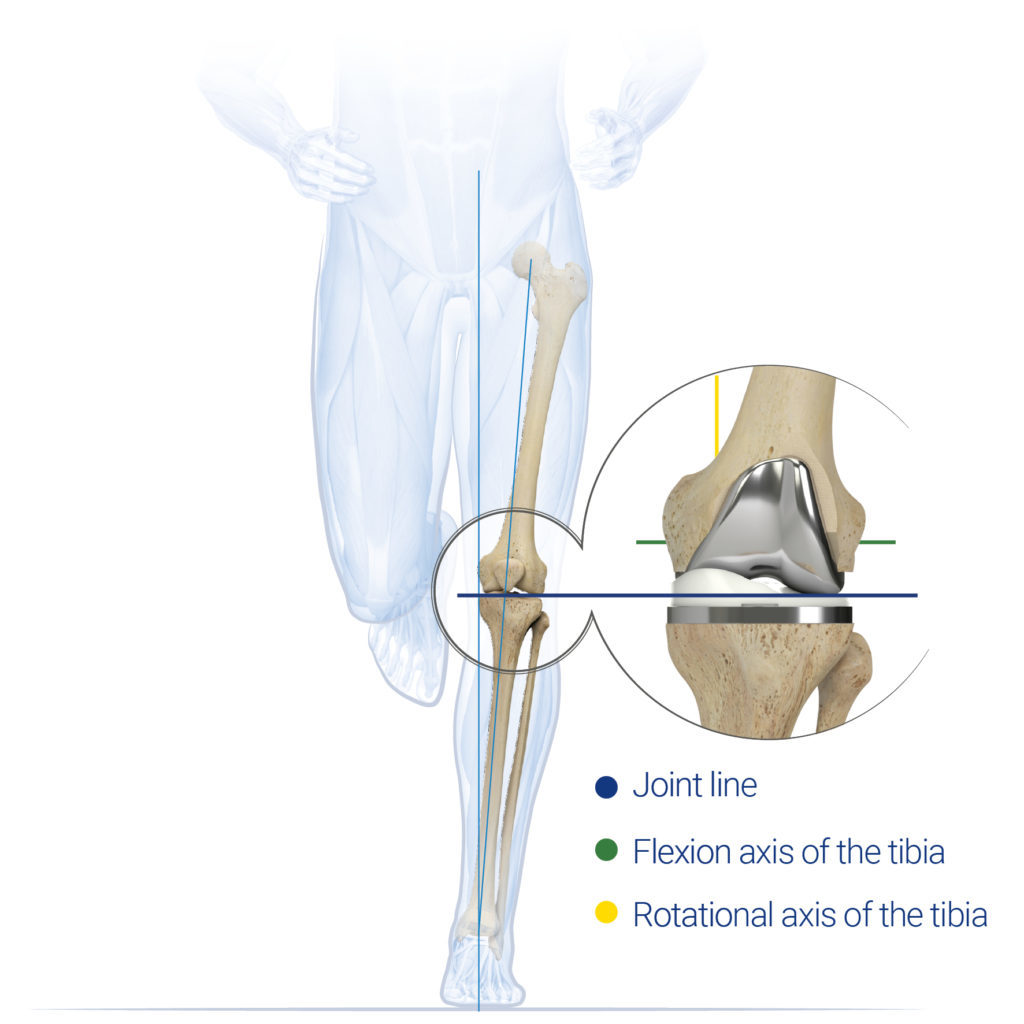A total knee replacement is also known as a total knee arthroplasty. The surgery involves opening the knee joint through an incision on the front of the knee. The damaged surfaces of the joint are surgically removed. The joint is then resurfaced with metal and plastic parts. The parts are typically cemented into position. All three bones of the knee are resurfaced—the femur, tibia and patella. This surgery may be performed with a surgical robot or computer navigation system. You are allowed to walk immediately after surgery. The surgery is commonly performed as an outpatient and rarely requires a hospital stay.
Medacta Knee Alignment and Stability with MIKA® and GMK® Sphere

What is a total knee replacement?
Total knee replacement surgery aims to substitute the bone and cartilage of the joint damaged by arthritis with metallic and plastic implants.
The surfaces of the thigh and shin bones are replaced with high-resistant metallic components, called the femoral component and tibial baseplate.
Between the femoral component and the tibial baseplate, a plastic tibial insert is implanted. It replaces the cartilage function allowing the thigh and shin bone to slide on each other. All materials used in a total knee replacement are highly biocompatible.
Why total knee replacement?
With almost 50 years of history, total knee replacement surgery is a very common and safe procedure for the treatment of severe arthritis. Approximately 1,000,000 knee replacements are performed annually worldwide.
The main benefits of a successful total knee replacement are:
- Reduction of knee pain
Pain may be rapidly and dramatically reduced, or potentially eliminated! - Recovery of mobility
You may dramatically improve the mobility of your knee. - Improvement in quality of life
Your everyday activities may no longer be limited by pain and reduced mobility!

Knee alignment and MIKA®
We all recognise that people look different, their faces and their bodies. It turns out that knees are also different in shape and alignment, even when they are healthy. Although a lot of legs are almost straight, many are naturally Varus (bow-legs) or Valgus (knock-knees). Knees can become more Varus or Valgus as a result of disease (arthritis) but it may not be ideal to try to make all knees straight after surgery.
Individualised Kinematic Alignment (MIKA®)
Traditional surgery using Mechanical Alignment (or MA), aims to give every patient a straight “knee alignment” even if the patient’s leg wasn’t naturally straight when healthy.
With Kinematic Alignment (or KA), the surgeon aims to restore the natural knee shape and alignment that
each patient had when their knee was still healthy – matching the knee replacement to each patient’s individual
anatomy.
Matching the patients individual leg shape means Kinematic Alignment can potentially make recovery easier
and faster[7], compared to traditional surgery it may improve the patient’s pain[8] and, possibly, improve the
biomechanics of walking and daily activities.[9]
GMK® Sphere: The Medially Stabilised Knee
A normal knee is a complex structure – when it bends, the lateral (outer) side rolls back, while the medial (inner) side remains stable. The GMK® Sphere knee implant is designed to provide a more natural motion that replicates this movement of the healthy knee. It allows stability in the inner side through a ball-in-socket mechanism. Stability is important for common activities such as going up and down stairs, sit to standing, getting into a car, and more demanding activities like shopping and gardening.


Stability Is Important For Patients
The medial ball-in-socket mechanism of the GMK® Sphere helps to replicate the function and the stability provided[10,11] by the natural ligaments and structures of the knee, most of which are removed during total knee replacement.Many patients prefer a stable knee design with a medial ballin-socket compared to other conventional knee designs, as they feel more natural, more stable and stronger during common daily activities.[12]
References
[7] C. Rivière et al. Alignment Options for Total Knee Arthroplasty: A Systematic Review. OTSR 2017-Nov; 103(7): 1047–56.
[8] Dossett, et al. A Randomised Controlled Trial of Kinematically and Mechanically Aligned Total Knee Replacements: Two-Year Clinical Results. BJJ 2014-Jul; 96-B(7): 907–13.
[9] P.A. Vendittoli. et al. Kinematic Alignment in Total Knee Arthroplasty Better Reproduces Normal Gait than Mechanical Alignment. KSSTA 2019-May; 27(5): 1410–17.
[10] P. Schütz et al. “Kinematic Evaluation of the GMK® Sphere Implant During Gait Activities: A Dynamic Videofluoroscopy Study.” JOR 2019- Nov; 37(11):2337–47.
[11] S. Banks et al. “Can a Total Knee Arthroplasty Be Both Rotationally Unconstrained and Anteroposteriorly Stabilised?: A Pulsed Fluoroscopic Investigation.” Bone Joint Res 2016-Mar; 5 (3):80–86.
[12] Pritchett, James W. “Patients Prefer A Bicruciate-Retaining or the Medial Pivot Total Knee Prosthesis.” JOA 2011-Feb; 26(2): 224–28.
Copyright © 2021 Medacta